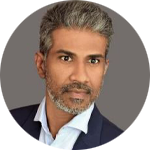Sudhir: Welcome to EY India Insights podcast. I am Sudhir, your host and I am thrilled to introduce our new series - Navigating Alliances. Join us as we explore the exciting world of strategic relationship and alliances. Learn how our teams collaborate with the vast ecosystem, harnessing global alliances to empower clients with transformative technology and insights. Today, we are joined by Sameer Prakash, Tax Technology and Transformation Partner, EY India and Nitin Kotian, Regional Vice President of India & Asia South at UiPath. They have decades of expertise in driving digital transformation through strategic partnerships.
Sameer, Nitin, thank you very much for joining our podcast today.
Sameer: Thank you for inviting us. Looking forward to the conversation.
Nitin: Same here. Thank you very much. Pleasure to be here.
Sudhir: Sameer, my first question is for you. How impactful has AI and Generative AI (GenAI) been in the tax ecosystem?
Sameer: Before I answer the question, let me set the context of where tax is right now in this journey. What we are seeing is an interesting transformation, driven by some regulatory changes that have happened in the recent times. To give you an example, clients are now required to report data to the government in real time, and the tax function, in many ways, is seen as acting as a custodian of this data that goes out to the government.
This real-time sharing of enterprise data with the government is what I like to term as the application programming interfaces (APIs) economy, where companies interact with external stakeholders such as suppliers, customers, and the government electronically through APIs. The question is: Is tax geared up for this kind of real-time reporting? The answer is, no.
The conventional set of technologies for finance and reporting do not cater to this kind of new requirement. And that is exactly where we see a strong play for emerging tech such as AI and GenAI, which can help bridge this gap and make them ready for this new, tough operating environment, which is at play right now.
What we have seen is that several clients are initiating digital transformation in digital initiatives to see how they can drive more digitization of tax. We see AI playing a key role there and we are seeing some excellent results. We look forward to witnessing how this whole space evolves.
Sudhir: Thank you so much, Sameer. Nitin, your take, please.
Nitin: We are at a time in our industry when it is not evolution, it is almost revolutionary. There has been a lot of commentary on the impact of GenAI and AI; there have been numbers shared about the kind of impact that can be made to the global GDP. The best part is, we are right at the beginning. While AI itself is not new, the combination of GenAI and (other types of) AI, along with other technologies which are part of the digital automation cloud, is very significant.
We see this cutting across every industry, persona and role, and it can deliver some amazing outcomes as we go along on this journey. We are at an interesting point in history and evolution on the technology curve.
Sameer: I would like to add that especially with GenAI, when I look at EY and Tax, there is a huge internal transformation opportunity in front of us; in the way we offer our services to our clients. That itself poses a huge opportunity, not only for us but also to our clients.
Sudhir: How beneficial has the hyper tax automation platform, which we have developed jointly with UiPath, for our clients?
Sameer: To give a quick brief on what the platform is, we have taken three or four different technologies, bundled them together and hosted them on a cloud. What are these technologies? We use robotic process automation (RPA), and UiPath is leading in that (technology).
Many tax processes are rules based. We use document intelligence because there is a lot of unstructured data that we need to consume, using AI and analytics. We have also taken a design-centric thinking and are trying to build a solution in a way that is quite easy for our clients to use and consume. This is a great way for our clients to access AI and some of the new technologies, which are otherwise very hard for clients to access in a simple and easy way.
The other thing we have done differently is that we have made it into an OpEx model. So, instead of clients investing a huge amount of capital upfront, we usually structure in such a way that clients have to pay over a period of time.
With these two approaches, we have made it quite easy for our clients to use the platform/technology. We have heard positive reviews from our clients in terms of what it (the platform) can do and the kind of innovation that we can drive through this approach.
Sudhir: Nitin, would you also like to shed some light on the Hyper tax Automation solution?
Nitin: This has been a wonderful and interesting journey for us along with EY. I and Sameer have had several conversations on how to take an existing tax platform, which is very rules-based, and infuse the latest and greatest technologies in it.
We saw the initial opportunity in automation, determining how to bring in as much automation as possible to repetitive tasks. But as we progressed on this journey and as we were building this solution and offering, we wanted to explore one of our technologies called Intelligent Document Processing (IDP), which works on a specialized AI foundation that allows users to intelligently classify documents, extract data, provide context, and then let the bots or automation tools act on it. That was the second step in the journey. As we were about to go to market, GenAI came into the picture, and we pivoted on that quickly. We also explored how we could bring in more of GenAI into the whole offering. So, the way I see this is that it is going to be a continuous learning process; we do deep learning, we train the model, we build the ML (machine learning) models, and that is how I see this evolving.
Sudhir: For our listeners, I would like to mention that in October 2023, UiPath awarded EY India as the Global Innovation Partner for the Year in Las Vegas.
Nitin: That was definitely a jewel in the crown for us for this partnership. One is the fact that we were able to move so quickly with EY India to not only build it (solution) but also present it to a large customer group in Delhi. We were also able to then put this into action at a very prestigious client in India in the telecom sector. The award was not just for innovation but delivering at speed as well. Kudos to Sameer and his team for that.
Sudhir: Looking ahead, Nitin, how do you see the future of AI and GenAI not just in India, but for global markets as well?
Nitin: I do not know if I am really in a position to comment on that. The market has just opened up or even exploded. There was the initial hysteria and hype; around November 2022 when GPT3 came out. Since then, things have settled down to an extent where every client or customer is not just experimenting but seriously looking at use cases.
We have reached a stage where most customers believe this can significantly impact their business. When I say business, I mean opportunities related to areas of experience. So, it could be employee experience (EX), it could be customer experience (CX). How do we change the narrative from just delivering productivity gains, which was being done through automation? It is also about how we deliver experience.
The opportunity is there. More new use cases are getting discovered and deployed. Some of the early adopters are industries in India, including healthcare, financial services, and banking, of which tax is also a part. Anything that is customer services oriented because of which there is a huge contact center deployment. How do you completely change the paradigm on customer experience? You are bringing in AI-powered agents on the contact center side.
Then you are delivering IT services. AI is going to really bring down time taken to build applications. We were already using Low-Code and No-Code. There is a huge amount of automation but using GenAI can really cut down time needed to build and develop products and applications. So, IT services is another big area that we are seeing testing on the developer side.
These are the early areas. We are right at the beginning of a sort of a revolution. It is early days, but it will impact each and every one of us.
Sudhir: AI seems to be absolutely everywhere right now. Sameer, your thoughts, please.
Sameer: According to recent research on top 10 areas where GenAI will an impact, tax is at the seventh position in that list, but the speed at which it is moving is unprecedented. We have not seen anything going that fast. Even within EY, one of the investments that we are making in this space, is at a different level. In my view, we are just at the beginning of this curve and the next couple of years will be very transformative for tax.
With Nitin and us, we are very well positioned to be able to help clients in this journey as they go. So, very exciting times ahead in the next couple of years, I would say.
Sudhir: Thank you very much for that. This is obviously an exciting vision for our future. Shifting gears slightly, Nitin, how valuable has the EY and UiPath alliance been in building giant solutions and capturing the markets?
Nitin: I will answer this in two ways. EY is a network of firms. We work with EY globally, as an entity, and then we work with EY at a network firm level, which is at an India level. Globally, EY is one of our largest partners and clients; we term you as a global System Integrator (SI), which means there is a lot of strategic engagement that happens and investments that happen on both sides. One of the key pillars of that strategy is how we marry your domain expertise, technology and consulting experiences to build a synergistic, solution-led value proposition for our customers. This can cut across industries, technology areas, or it can be domain specific.
Tax is one area, and we have taken the lead here from an India standpoint. Usually, it is the global team that builds a solution, and it gets rolled out. In this case, we want to do the reverse. We build it out in India, and Sameer and I want to expand it into other geographies and markets and truly make it a global platform at some point.
There are other such initiatives as well; EY has a team in the UK that we work closely with to build offerings that will be rolled out over the coming months and weeks.
Also, the fact that we have this platform available which brings in both GenAI capabilities and what we call specialized AI capabilities. EY will see how best it can be embedded into many more platforms, not just tax. For example, ESG is a platform that you (EY) were part of. So, we are looking at all those possibilities.
Sudhir: Sameer, what is your take on the alliance and goals for the future?
Sameer: One of the things that allowed us to move so fast is the technology, because we just saw that we are able to innovate very quickly using the existing technology that UiPath has to offer.
But more than the technology, what I must say is the whole teaming that happened between us and Nitin. It allowed us to move a lot faster than what we could have on our own or with any other partner.
This partnership is very strategic to us. There is a long journey that we will do together. We are really looking forward to seeing how we can create a huge market impact as GenAI unfolds in the next couple of years.
Sudhir: That is indeed impressive. What lies in store for the EY and the UiPath alliance?
Sameer: The recognition that was provided to us by UiPath team as Global Innovation Partner of the Year was noticed across the EY network. As Nitin mentioned, we see India as a pilot and how this can be one of those offerings that can start from India and then we can replicate that across the global firm.
To me, that is huge. That is the conversation that we are having internally within EY with a lot of the global leaders. I am excited that this is one of those unique things that we would have incubated in India and taken it global, and that itself will be a massive opportunity for both us and UiPath.
Sudhir: Nitin, would you like to add to that?
Nitin: Yes, going global for sure. But what this has also proven is that EY India along with UiPath India can be an innovation hub, for both the companies.
We can also become a hub for other markets, where we create the solution because the talent is here in India. We have made some major commitments on building talent on AI India in the recent UiPath DevCon event held in Bengaluru (February 2024).
I also see more collaboration happening with EY India locally for markets beyond India. It almost becomes like a Center of Excellence (CoE) that we build here. Big things can come out of India for sure through this partnership.
Sudhir: What AI-related challenges or bottlenecks do we foresee and how do we ensure our clients are not held back in their adoption of AI in the future?
Nitin:  There are definitely challenges and we have seen that in the early part of the release of the technology. What we have done as an organization is that we created a trust layer within the platform. What we actually mean by trust layer is how to ensure that there is a good understanding of the implications of the predictions provided by the LLMs; how to provide transparency in terms of what sort of features and functionality are being used by the AI models. Then, of course, how to provide that a certain level of control so that sensitive data is filtered; and you are not exposing the company’s intellectual property (IP). This is critical because we are talking enterprise and critical data. One bad step can really push that entire agenda back. We are doing our bit, and partnering with the EY also allows us to bring in that credibility from a solution standpoint.
There are definitely challenges and we have seen that in the early part of the release of the technology. What we have done as an organization is that we created a trust layer within the platform. What we actually mean by trust layer is how to ensure that there is a good understanding of the implications of the predictions provided by the LLMs; how to provide transparency in terms of what sort of features and functionality are being used by the AI models. Then, of course, how to provide that a certain level of control so that sensitive data is filtered; and you are not exposing the company’s intellectual property (IP). This is critical because we are talking enterprise and critical data. One bad step can really push that entire agenda back. We are doing our bit, and partnering with the EY also allows us to bring in that credibility from a solution standpoint.
I will let Sameer share his thoughts on this too.
Sameer: My view is that the guardrails that we build will be important. UiPath is already beginning to build those guardrails on privacy and other things. The other reason clients are a little held back is the perception that this will take away their jobs. That to me is an equally important challenge and in my view, it is only a matter of time before people realize that this is a really a tool to aid them in being more productive in the way they work and not necessarily a threat to what they do.
That is a misconception, which needs to be overcome for this solution to truly get to its potential.
Nitin: Absolutely.
Sudhir: On that note, I have to say thank you very much, Sameer and Nitin, for joining us and taking time off your busy schedules, sharing your expertise and your insights. This has been an extremely enriching and insightful conversation. It has been a pleasure having you both on the show.
Nitin: Thank you, Sudhir.
Sameer: Thanks a lot Sudhir. Hopefully, we can come back in six months and talk about what we have jointly achieved. So, looking forward to that.
Sudhir: Indeed. Thank you to all our listeners for joining us on this episode of Navigating Alliances series. Stay tuned for more episodes, where we unravel key insights from the EY Partner Ecosystem (our strategic relationships and alliances). Until then, if you would like us to cover any specific topic for discussion, please feel free to share it with us on our website or mail to us markets.eyindia@in.ey.com.
Thank you very much for tuning in and goodbye!




